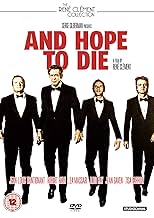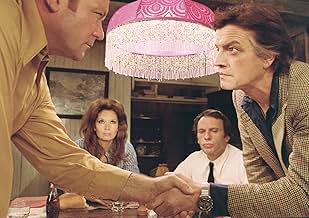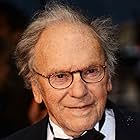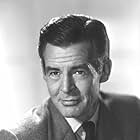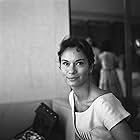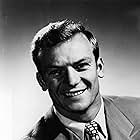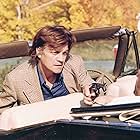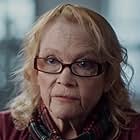La corsa della lepre attraverso i campi
Titolo originale: La course du lièvre à travers les champs
VALUTAZIONE IMDb
6,7/10
895
LA TUA VALUTAZIONE
Un ladro in fuga si lega a una banda criminale per commettere un rapimento. Tuttavia, le cose non vanno come previsto.Un ladro in fuga si lega a una banda criminale per commettere un rapimento. Tuttavia, le cose non vanno come previsto.Un ladro in fuga si lega a una banda criminale per commettere un rapimento. Tuttavia, le cose non vanno come previsto.
Aubert Pallascio
- Renner
- (as Louis Aubert)
Trama
Lo sapevi?
- QuizFilm debut of Emmanuelle Béart.
- BlooperThough the main characters except for Trintignant's are supposed to be French Canadian none of them speak with the distinctive Quebecois accent but instead speak Parisian style French.
- Versioni alternativeThe original version released in Europe ran 140 minutes. Soon after, it was cut once again to 127 minutes. When it arrived in the United States, it was further cut to 99 minutes.
- ConnessioniReferenced in Mean Streets - Domenica in chiesa, lunedì all'inferno (1973)
Recensione in evidenza
René Clément's LA COURSE DU LIÈVRE À TRAVERS LES CHAMPS/AND HOPE TO DIE is based on the David Goodis novel "Black Friday." Jean-Louis Trintignant (A MAN AND A WOMAN, THE CONFORMIST) stars as Tony, who arrives at a train station outside Montreal where several gypsies are waiting for him (a moment shot and scored like a Sergio Leone film, complete with the pan pipe accompaniment); although their comments are cryptic, we understand that a deal has gone sour, and the gypsies want Tony to settle the balance in blood. Eluding them, Tony manages to get into the city, where he witnesses the shooting death of gangster Renner (Louis Aubert), who passes him $15,000 in cash and makes even more cryptic comments, telling Tony that "Toboggan" has committed suicide, and that "Charley thinks he's smarter than the others."
Apprehended, Tony is led away from this scene by two men he believes to be cops; when they drive him out into the country, he realizes he's being kidnapped and pushes one of the men, Paul, out of the car, mortally injuring him. Recaptured and brought to an unused country hotel, Tony is introduced to an outlaw gang led by Charley Ellis (Robert Ryan), a career criminal who has spent ten of the last fifteen years in jail, and Charley's associates - Rizzio (Jean Gaven, also in Clément's LA PASSAGER DE LA PLUIE/RIDER ON THE RAIN), ex-boxer Mattone (Aldo Ray, in one of his last decent parts), the sultry Sugar (Lea Massari, from Sergio Leone's IL COLOSSO DI RODI and Antonioni's L'AVVENTURA) and the near feral Pepper (Tisa Farrow, in her second film), sister to the dying Paul. Knowing that Tony (whom he calls "Froggy") has his money, Charley doesn't kill the stranger, who soon bonds with the gang. When Paul dies, Tony gives up the cash to be allowed to join the gang to help finance his escape to Australia.
The caper is the kidnapping of a government witness - a mobster's moll who goes by the name of Toboggan. Only Charley - and Tony - know that the woman is dead - but they decide to go through with the plan, collect the reward from the underworld for delivering the witness and to get out of the country before anyone's wise.
AND HOPE TO DIE is an odd, unsatisfying but compelling little film. Released in November of 1972 with a PG rating, it has neither graphic violence or sexuality, but offers an endearing cast of supporting players. Near the end of his life, Robert Ryan (who died of cancer in 1973), breathes and spits world weariness, alternatively even-tempered and explosive - the kind of thug who creeps you out more by smiling than scowling. Jean-Louis Trintignant was in a transitional phase here between his stint as Euro smoothie (AND GOD CREATED WOMAN, LES LIAISONS DANGEREUSES) and character actor (CONFIDENTIALLY YOURS, UNDER FIRE); we never quite know what's up with Tony - although he pleads to the murderous gypsies that he's "just a bookseller," he occasionally flashes on the black and white image of a child who is either sleeping or dead - we never quite know what this means. Ray, Gaven and Massari are all great as the more seasoned gang members, and Tisa Farrow is typically awkward as Pepper, but certainly believable as the "unsophisticated" girl-child. Emmanuelle Béart is briefly glimpsed as a young child.
Francis Lai (A MAN AND A WOMAN, LOVE STORY) contributes a melancholy score that glides from ominous lower strings to pan pipe interludes and guitar melodies evoking sadness and disappointment - a recurring motiff quotes "I Love Paris In The Springtime." Cinematographer Edmond Richard had previously filmed Orson Welles' CHIMES AT MIDNIGHT and DON QUIXOTE, and would go on to shoot THE DISCREET CHARM OF THE BOURGEOISIE and THAT OBSCURE OBJECT OF DESIRE. Second assistant director Jean-Jacques Beineix would go on to greater glory by directing DIVA (1981) and BETTY BLUE; in 1972, Beineix would also serve as second AD on the infamous Jerry Lewis film THE DAY THE CLOWN CRIED, and tried his hand at his own Goodis adaptation with the poorly received THE MOON IN THE GUTTER.
Clément and screenwriter Sébastien Japrisot (who had also scripted Clément's LA PASSAGER DE LA PLUIE, and wrote the novel "The Lady In The Car With The Glasses And The Gun") start this tragic story with a quote from Lewis Carroll: "We are but older children dear/Who fret to find our bedtime near," and bracket the action with scenes of children playing in the streets of Paris. We are made to identify these children with the gang members (indeed, several of them have clothing or activities that force the parallels); ultimately, it's difficult to tell if these children are the gang members when young or if it's merely a way of showing the universality of human behavior.
Apprehended, Tony is led away from this scene by two men he believes to be cops; when they drive him out into the country, he realizes he's being kidnapped and pushes one of the men, Paul, out of the car, mortally injuring him. Recaptured and brought to an unused country hotel, Tony is introduced to an outlaw gang led by Charley Ellis (Robert Ryan), a career criminal who has spent ten of the last fifteen years in jail, and Charley's associates - Rizzio (Jean Gaven, also in Clément's LA PASSAGER DE LA PLUIE/RIDER ON THE RAIN), ex-boxer Mattone (Aldo Ray, in one of his last decent parts), the sultry Sugar (Lea Massari, from Sergio Leone's IL COLOSSO DI RODI and Antonioni's L'AVVENTURA) and the near feral Pepper (Tisa Farrow, in her second film), sister to the dying Paul. Knowing that Tony (whom he calls "Froggy") has his money, Charley doesn't kill the stranger, who soon bonds with the gang. When Paul dies, Tony gives up the cash to be allowed to join the gang to help finance his escape to Australia.
The caper is the kidnapping of a government witness - a mobster's moll who goes by the name of Toboggan. Only Charley - and Tony - know that the woman is dead - but they decide to go through with the plan, collect the reward from the underworld for delivering the witness and to get out of the country before anyone's wise.
AND HOPE TO DIE is an odd, unsatisfying but compelling little film. Released in November of 1972 with a PG rating, it has neither graphic violence or sexuality, but offers an endearing cast of supporting players. Near the end of his life, Robert Ryan (who died of cancer in 1973), breathes and spits world weariness, alternatively even-tempered and explosive - the kind of thug who creeps you out more by smiling than scowling. Jean-Louis Trintignant was in a transitional phase here between his stint as Euro smoothie (AND GOD CREATED WOMAN, LES LIAISONS DANGEREUSES) and character actor (CONFIDENTIALLY YOURS, UNDER FIRE); we never quite know what's up with Tony - although he pleads to the murderous gypsies that he's "just a bookseller," he occasionally flashes on the black and white image of a child who is either sleeping or dead - we never quite know what this means. Ray, Gaven and Massari are all great as the more seasoned gang members, and Tisa Farrow is typically awkward as Pepper, but certainly believable as the "unsophisticated" girl-child. Emmanuelle Béart is briefly glimpsed as a young child.
Francis Lai (A MAN AND A WOMAN, LOVE STORY) contributes a melancholy score that glides from ominous lower strings to pan pipe interludes and guitar melodies evoking sadness and disappointment - a recurring motiff quotes "I Love Paris In The Springtime." Cinematographer Edmond Richard had previously filmed Orson Welles' CHIMES AT MIDNIGHT and DON QUIXOTE, and would go on to shoot THE DISCREET CHARM OF THE BOURGEOISIE and THAT OBSCURE OBJECT OF DESIRE. Second assistant director Jean-Jacques Beineix would go on to greater glory by directing DIVA (1981) and BETTY BLUE; in 1972, Beineix would also serve as second AD on the infamous Jerry Lewis film THE DAY THE CLOWN CRIED, and tried his hand at his own Goodis adaptation with the poorly received THE MOON IN THE GUTTER.
Clément and screenwriter Sébastien Japrisot (who had also scripted Clément's LA PASSAGER DE LA PLUIE, and wrote the novel "The Lady In The Car With The Glasses And The Gun") start this tragic story with a quote from Lewis Carroll: "We are but older children dear/Who fret to find our bedtime near," and bracket the action with scenes of children playing in the streets of Paris. We are made to identify these children with the gang members (indeed, several of them have clothing or activities that force the parallels); ultimately, it's difficult to tell if these children are the gang members when young or if it's merely a way of showing the universality of human behavior.
- Richard_Harland_Smith
- 19 mar 2000
- Permalink
I più visti
Accedi per valutare e creare un elenco di titoli salvati per ottenere consigli personalizzati
- How long is ...And Hope to Die?Powered by Alexa
Dettagli
- Tempo di esecuzione2 ore 2 minuti
- Mix di suoni
- Proporzioni
- 1.85 : 1
Contribuisci a questa pagina
Suggerisci una modifica o aggiungi i contenuti mancanti

Divario superiore
By what name was La corsa della lepre attraverso i campi (1972) officially released in Canada in English?
Rispondi
